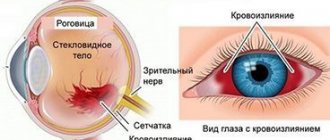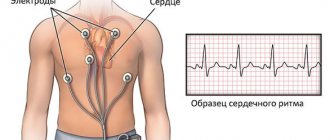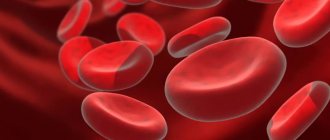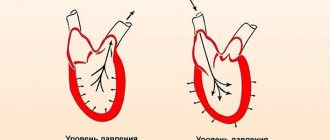Hemorrhage is a dangerous symptom.
No matter the location or cause, this is always a dangerous sign of pathology that requires urgent medical intervention.
This also applies to bleeding from the eyes. Hemorrhage in the eyes occurs due to a violation of the integrity of the vascular wall. But that's not the reason. This is the final point of a complex mechanism resulting from a specific pathological incident in the body.
Hemorrhage may resolve on its own or may lead to permanent vision loss. In any case, if a symptom occurs, an early ophthalmological examination is necessary.
Causes of bleeding from the eyes
There are different concepts - bleeding from the eyes and hemorrhage into the cavity of the eyeball or orbit. The first condition is hemolacria, or the release of blood along with tear fluid. This is a very rare symptom. This condition can be caused by trauma, tumors or infection of the lacrimal glands and ducts, acute injuries to the skull, and poison intoxication (from a snake bite). History describes cases of hemolacria in young people and children, which appeared and disappeared suddenly. No processes that could cause this strange condition have been identified.
The described cases remain a mystery. A rare cause of hemolacria in women is extragenital endometriosis, usually a congenital malformation. This is the growth of endometrial tissue (the inner layer of the uterus) on other organs, in particular on the conjunctival membrane. In this disease, blood comes from the eyes during menstruation.
The second concept is hemorrhage in the eye - a state of bleeding into the structures of the eye, between them, into the orbital cavity. There are many causes for this symptom:
- increased intraocular pressure in glaucoma;
- retinal disinsertion;
- injury to the eyeball (contusion) or base of the skull (symptom of glasses);
- excessive physical activity;
- severe emotional stress;
- prolonged overstrain of the organ of vision;
- sudden dive to depth (diving);
- sudden jumps in blood pressure;
- sharp uncontrolled jumps in blood sugar - from high hyperglycemia to deep hypoglycemia;
- autoimmune diseases accompanied by vascular damage (systemic vasculitis);
- DIC syndrome, blood clotting disorders;
- severe vitamin K deficiency;
- taking antiplatelet agents and anticoagulants (to thin the blood);
- neoplasms of the eye elements (their pressure on the structures of the eye and blood vessels causes a violation of their integrity);
- foreign object entering the eye;
- after major surgical operations.
A sudden dive to depth, physical and emotional overload lead to a rapid increase in pressure inside the blood vessels. Since the vessels of the visual system are small with fragile walls, they suffer first.
How to get rid of eye redness due to burst blood vessels
With hyposphagma, as a rule, no special treatment is required. When bleeding into the space between the conjunctiva and sclera, most often it is enough to simply wait until the red spot resolves. Unfortunately, this takes several days, and there are no remedies that give an immediate effect and help get rid of the hemorrhage immediately.
However, you still need to contact an ophthalmologist. The fact is that burst blood vessels can indicate various diseases, as well as the fact that you need to change your lifestyle. The specialist will conduct an examination and, if necessary, prescribe treatment.
An ophthalmologist may recommend eye drops or other medications that have a good absorption effect. The dosage is determined for each patient individually and is usually 1-2 drops 2-4 times a day for 10-15 days.
Also, if you have a burst vessel, it is necessary to eliminate the causes and prescribe treatment. Examples of possible sources of illness:
- if the cause is inflammatory eye diseases, a specialist may prescribe eye drops with antiviral or anti-inflammatory effects;
- if the blood vessels burst due to increased physical activity during training, the doctor may advise you to temporarily stop active exercise;
- if the cause is high blood pressure or general diseases of the body, the ophthalmologist will recommend contacting the appropriate specialists.
Find your nearest optical store
Typically, a red spot in the eye will completely resolve within about 7-10 days. But on the first or second day after you notice the hemorrhage, you may experience that its area will increase. This is not usually caused by the bleeding continuing. It’s just that the blood that gets between the conjunctiva and the sclera is redistributed, the thickness of the clot decreases, and the area increases. After some time, the growth of the spot will stop, and it will gradually begin to decrease.
Risk group
People at risk of intraocular hemorrhage include patients with hypertension and diabetes mellitus. These are patients who do not control blood pressure or sugar levels and do not receive constant rational therapy.
Therefore, they are at risk of not only vascular complications. Irrational and uncontrolled treatment also includes thoughtless use of blood thinning drugs. These categories of people need regular examination by specialized doctors and control of tests with due frequency.
The risk group includes people with the pathological conditions presented above. This also includes those who enjoy scuba diving. This is an extreme activity. Professional training is required before diving. This also applies to lovers of skydiving, ski jumpers and those involved in a more dangerous type of jumping from cliffs and from extremely high points. A full medical examination and appropriate permission are a prerequisite for engaging in such activities.
Professional athletes whose activities involve high speeds, running, fighting, and jumping are therefore at risk. They can get injured at the base of the skull (from a fall), or to the eyes (in martial arts, football players). Athletes and bodybuilders are in a state of constant physical overstrain. This is an additional risk factor for ocular hemorrhages.
People addicted to alcohol. Alcoholic drinks in large quantities cause aggression. People intoxicated often get involved in fights, which do not always end well.
No one is immune from neoplasms. Until now, it has not been possible to identify a reliable reason for the development of cancer cells in humans. Therefore, prevention consists of maintaining immunity, regular examinations by doctors for early detection of the tumor and its removal in the first stages of the disease.
People in stressful professions - doctors, lawyers, businessmen. Shop workers and miners are susceptible to the penetration of foreign bodies into the eyeball. It is very important for them to wear personal protective equipment when working. Workers in hot shops are exposed to changes in temperature and pressure, which also poses a risk of surges in intravascular pressure.
What not to do if blood vessels in the eye burst
First of all, you should not self-medicate. You should not go to the pharmacy and consult a pharmacist about what drops you need if a blood vessel has burst. You risk not only choosing an ineffective remedy, but also worsening your eye condition. Do you need eye drops, and if so, which ones and in what quantity to instill them - all this should be discussed with an ophthalmologist. For questions related to wearing contact lenses, you should also consult a specialist.
Also, if a blood vessel has burst in your eye, you should not:
- touching the eye and especially rubbing it - this can increase hemorrhage;
- rinse the eye - this can also cause increased hemorrhage;
- continue to wear contact lenses - they will have to be removed;
- make warm lotions, for example with tea or herbal decoctions;
- use traditional medicine recipes from the Internet.
Classification of hemorrhages
Depending on the structure of the eye that has undergone bleeding, there are:
- hemophthalmos;
- hyphema;
- subconjunctival hemorrhage - hyposphagma;
- retinal - into the retina;
- into the orbit, soft tissues of the eye.
Hyphema is the penetration of blood into the anterior chamber of the eye. This condition is a common consequence of blunt trauma to the eye area and is accompanied by pain. Hemophthalmos is characterized by bleeding into the vitreous body - this is a complex and dangerous condition that requires urgent resolution. Symptoms include the appearance of fog before the eyes, which does not go away with blinking, and blurred vision. The retina is the most sensitive part of the eyeball. Small changes in blood vessels easily lead to bleeding. Disposing of excess blood from the retina without damaging its functions is not an easy task.
Hemorrhages can be classified according to severity - from mild to severe, according to the breadth of distribution and involvement of other structures, unilateral or bilateral, for reasons - ocular and somatic.
Symptoms
The main symptom of hemolacria is the discharge of blood from one eye or from two organs of vision at once. Tears may have a bright bloody scarlet color, a light reddish tint, or contain streaks and inclusions of blood particles.
Helpful information! One small tear of blood may go unnoticed, but a person literally crying blood is sure to attract attention.
Along with blood in the eyes, other accompanying symptoms may be observed: pain, burst eye vessels, itching or burning of the visual organs, visual disturbances (flashes, spots, lightning, narrowing of visual fields, blurred vision), as well as general signs such as malaise, increased body temperature, weakness and others.
First aid
First aid for hemorrhage involves immediately calling an ambulance or going to an emergency room yourself. Before providing medical assistance, you should apply ice (any cold object) to the eye area.
It is forbidden to rub your eyes - this will increase the bleeding, and a possible infection that has penetrated into the blood will spread throughout the body.
You cannot use eye drops yourself or try to remove a foreign body. It is necessary to wait for the doctor, who will explain in detail the circumstances of the occurrence of the process, inform about existing diseases, allergies and medications taken.
Symptoms and diagnosis
To detect hemorrhage, it is often enough to look at the whites of the eyes. Red spots appear on them. If hemorrhage occurs in the sclera, the person does not feel discomfort. Retinal hematomas also do not cause pain, but occasionally black spots may appear in front of the eyes, and the contours of objects become blurred.
In addition to blood on the whites of the eyes, there may be a sensation of a foreign body in the eye, which gradually passes. Hyphema causes blurred vision and increased sensitivity to light.
With hemophthalmia, the symptoms are more pronounced. The patient sees dark spots, flashes, floaters and dots before his eyes. In the morning, vision deteriorates as blood particles move and are evenly distributed throughout the vitreous body.
If a large amount of blood is released, exophthalmos occurs. The eyeball moves forward, bloody discharge comes from under the lower eyelid.
Treatment
Eye bleeding should only be treated by a doctor. Depending on the severity of the disease, the doctor chooses conservative or surgical treatment. Hyposphagma tends to resolve on its own. The doctor's help consists of excluding serious pathology, infection, prescribing decongestant, anti-inflammatory solutions and monitoring the dynamics.
Therapy is selected strictly individually. Surgery may be required. If a lot of time has passed since the injury and the wound has festered, removal of the eye is not excluded.
The task of the victim and his immediate environment is not to panic, provide first aid, deliver the patient to a medical facility as soon as possible, and strictly follow medical prescriptions.
What to do if symptoms appear
- Do not self-medicate under any circumstances.
- At the first symptoms, consultation with an ophthalmologist is necessary.
- Initiate necessary therapy in a timely manner
- Maintain hygiene
If the inflammatory process appears only in one eye , without timely treatment the process can spread to the healthy eye.
It is important to promptly identify inflammatory processes in children; we must remember that children rarely complain of visual discomfort.
What to do if the tears are bloody?
As you can see, there can be many reasons. However, some of them are very dangerous. They indicate the development of very severe pathologies that can lead to death. There can be no talk of any self-medication. You need to immediately go to an ophthalmologist. If necessary, he will refer you to other specialists for examination.
If hemolacria is accompanied by fever, pain, dizziness, decreased vision and other signs, call an ambulance.
Injuries to the cornea of the eye
Most often, corneal injuries are caused by scratching with a fingernail or other foreign body, but more serious injuries, such as chemical burns, can also occur.
All corneal wounds are divided into linear and patchwork. They can be of various sizes and shapes. Clinical manifestations: lacrimation, photophobia, eye pain, blepharospasm. If an infection occurs, inflammatory infiltration of the wound edges can be detected.
To diagnose a non-perforated corneal wound, in addition to anamnestic and clinical data, the following method is used: drops of a fluorescein solution (1%) are instilled into the conjunctival sac, followed by rinsing with a sodium chloride solution (isotonic). The injured area of the cornea will turn yellow-green.
Treatment
Analgesics are not used for injury to the cornea of the eye, because this delays the healing process. Epithelization occurs within a few days without leaving a trace. If the damage was deep, it is possible that after healing there will be an area of cloudiness, which (sometimes) reduces visual acuity. In general, the prognosis for corneal injuries is favorable.
Why do my eyes turn red?
Redness of the eyes
Redness of the eyes usually refers to redness of the sclera - the white membrane of the eye. The sclera contains a significant number of capillaries - the smallest blood vessels. Usually they are invisible, but under the influence of a number of circumstances, the blood vessels of the sclera can expand, the walls of the vessels stretch as they expand, and then we see them, or rather, we see the blood filling the vessels. The blood is red, causing the eyes to appear red.
In most cases, dilation of scleral vessels is caused by a sharp increase in blood circulation. This is how the body responds to a fairly wide range of problems. Blood is an internal transport through which nutrients are delivered and toxins are removed. Blood flow helps increase local immune defense and accelerates healing. In many cases, the redness of the eyes goes away quite quickly; this means that the blood supply to the sclera has returned to normal. If the redness persists for a long time, then, obviously, the problem that caused it is quite serious.










